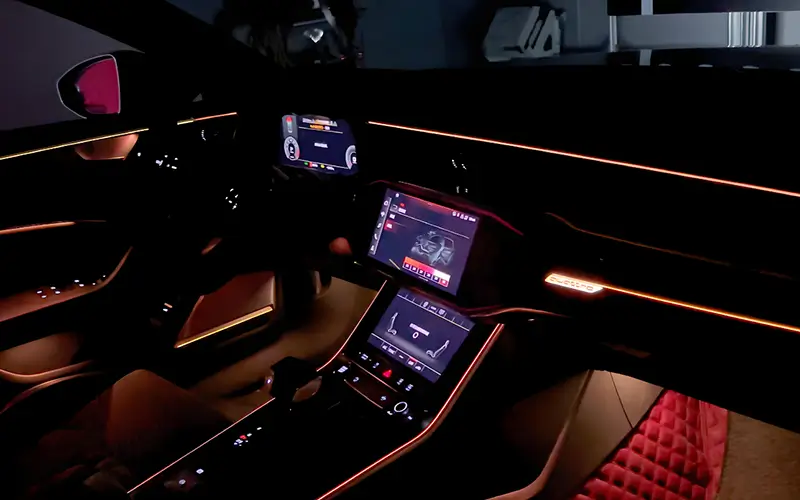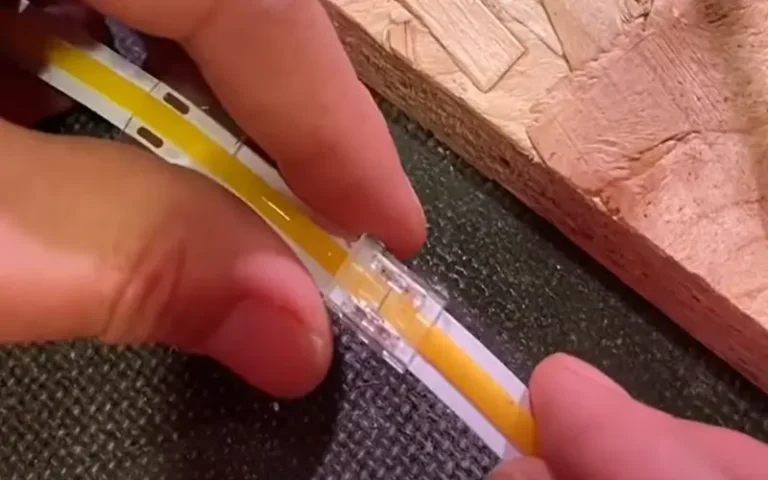How Do Use Battery Powered LED Strip Lights?
Conventional LED strips are powered by LED power banks. But for convenience and easy portability, most people want to use battery-powered LED strip lights.
It provides a simple and versatile way to illuminate spaces where power outlets are not available, such as cabinets, cars, outdoor areas, or temporary setups. These battery-powered solutions offer the flexibility to use LED strips in a variety of creative ways without the limitations of standard wiring.
However, choosing the right battery to powered your LED strip lights and understanding the limitations are essential to ensure an efficient and safe lighting setup.
Why Use Battery to Powered LED Strip Lights?
Using batteries to power LED strip lights offers several advantages. Especially for projects or spaces that require mobility or don’t have access to an electrical outlet.
Battery-powered LED light strips are great for outdoor lighting, cars, DIY projects, or anywhere temporary lighting is needed. Batteries allow you to easily install, move, or remove the lights without worrying about wires or outlets.
What Types of Battery Can Powered LED Strip Lights?
Now that we know that batteries can power LED strip lights, we need to know how to choose the right battery type. Because it is critical to the performance, convenience, and lifespan of LED light strips.
Different batteries offer different levels of power, size, portability, and lifespan. Here is an overview of the common battery types used to power LED light strips, as well as their pros and cons:
AA and AAA Batterie
This makes them a popular choice for low-power, short-term LED lighting. Each AA or AAA battery typically provides 1.5 volts, so multiple batteries need to be combined in a battery holder to match the voltage of the LED strip. This makes them a popular choice for low-power, short-term LED lighting
While these batteries are suitable for small, low-energy installations, their limited capacity means they cannot be used for very long with high-power strips. They are a practical solution for short-term uses, such as temporary displays or emergency lighting, where you do not need an extended power source.

Lithium-Ion Batteries
Lithium-ion batteries are known for their high energy density and rechargeable design. A single lithium-ion cell typically provides 3.7 volts, so they are often combined with other batteries to reach the desired voltage.
Lightweight and powerful, this battery is a great choice for both portable and permanent LED installations. Common forms include cylindrical 18650 cells or custom battery packs.
They are a bit more expensive, but provide reliable power for long-term use and are widely used in professional and DIY LED installations.
Rechargeable NiMH or NiCd Batteries
These rechargeable batteries are often used as a replacement for AA or AAA batteries, they have a lower energy density than lithium-ion batteries, but are more cost-effective and more environmentally friendly. Because they contain fewer harmful substances.
Nickel Metal Hydride (NiMH) and Nickel Cadmium (NiCd) batteries can be recharged many times and are ideal for LED strips that do not require extremely high power but do require a sustainable long-term power source.
Because they contain fewer harmful substances. However, NiCd batteries perform better in extreme temperatures. These batteries are best for medium-use and low-energy LED strips.
9V Batteries
Often used for specific, low-power LED applications, 9V batteries provide a simple solution when only a single battery is desired. However, they lack the capacity for extended use with high-power LED strips, as they drain relatively quickly. A 9V battery is typically more expensive per unit of power delivered compared to AA or AAA batteries, making it suitable only for small projects or low-power, short-duration applications where size and simplicity are prioritized.
Power Banks
Portable power banks are commonly used to charge cell phones and are a great choice for USB-compatible LED light strips. Power banks typically offer a 5V output, which is perfect for LED light strips that run on USB power.
They come in a variety of capacities (usually measured in mAh), with larger capacity power banks offering longer run times. This makes them ideal for outdoor events, mobile displays, or temporary lighting needs. Power banks are also rechargeable, meaning they can be used repeatedly without the need for disposable batteries.

How to Choose the Right Batteries to Power Your LED Strip Lights?
Choosing the right battery for your LED strip depends on several factors, including the voltage and power requirements of the LED strip, the duration of use, and portability.
- 1. Check the voltage of your LED strip: Most LED strips use a 12V or 5V power source. Make sure the battery you choose meets this requirement.
- 2. Consider the battery capacity (mAh): Batteries with higher capacity provide longer runtimes. If using AA or AAA batteries, consider rechargeable batteries for convenience.
- 3. Determine your power needs: Determine how long you need the LED to stay lit. For extended use, it is better to use a battery with a larger capacity, such as a lithium-ion battery or a power bank.
- 4. Weight and portability: For projects that require mobility, choose lightweight batteries.
How Long Will a Battery Last for an LED Light Strip?
Battery life depends on the type of battery used and the power consumption of your LED strip. As a general rule:
- AA batteries: A standard AA battery typically powers a 12V LED strip for around 2-3 hours.
- Lithium-ion batteries: These can last anywhere from 10 to 20 hours, depending on the battery’s mAh rating and the LED strip’s power draw.
- Power banks: High-capacity power banks can keep LED strips running for several hours, with a 10,000mAh bank lasting around 5-10 hours for a typical 5V strip.
Can I Power a 12V LED Strip with a 9V Battery?
While it is technically possible to power a 12V LED strip with a 9V battery, we recommend that you use a 12V battery to power the strip. About the 12V LED strip, pls read 12V LED Ribbon Lights: Powering and Wiring
The LED strip may not run at full brightness or may not work at all. It is best to use a battery with a voltage that matches or exceeds the rated voltage of the LED strip.
Can I Connect a 12V LED Strip to a Car Battery?
Yes, you can connect a 12V LED strip to a car battery. However, it is important to use a suitable fuse to protect the circuit.
Also, make sure to disconnect the battery when the car is not in use to prevent accidental discharge. Always disconnect the LED strip when not in use.

Will LED Strip Lights Drain My Car’s Battery?
If you leave your car’s battery connected to LED strip lights for an extended period, it can drain the battery. To prevent this, consider using a battery isolator or disconnecting the battery when the car is not in use.
Can I Use Batteries to Power Sensor Cabinet Lights?
Yes, batteries are an excellent option for powering sensor cabinet lights. Battery-powered sensor lights are ideal for cabinets, closets, and other small spaces where wired power may be impractical. When choosing a battery:
1. Look for AA or AAA options: These batteries are commonly used in sensor lights and are easy to replace.
2. Consider rechargeable options: If the sensor lights are used frequently, opt for rechargeable batteries to save on costs and reduce waste.
3. Check compatibility: Ensure that your sensor lights can run on battery power and that the batteries provide the necessary voltage.
Are Battery-Powered LED Strip Lights Safe?
Battery-powered LED strip lights are generally safe to use, but it’s important to follow safety guidelines:
- You need to use the correct type and size of battery.
- Avoid overcharging or over-discharging.
- Properly dispose of used batteries.
- Ensure that the wiring is secure and free of any exposed wires.
Can I Power LED Lights with a Power Bank?
Yes, you can power LED lights with a power bank. Many power banks have a USB output port that can be used to power USB-powered LED light strips.
However, the battery life of a power bank depends on its capacity and the power consumption of the LED light strip. By carefully considering these factors, you can effectively power LED light strips with batteries and enjoy their many benefits.
FAQs
Yes, LED strips can be powered by batteries. Generally, for small LED strips (e.g. strips about 2-5 meters long), you can use standard batteries (such as AA, AAA, or 9V). For longer or more power-hungry strips, we still recommend using an LED power bank.
Generally, 12V or 5V LED strips need to be powered by batteries. So you need a 12V battery, such as a 12V lead-acid, lithium-ion, or LiFePO4 battery. For smaller, low-power LED strips (e.g. 5V strips), you can use AA or AAA batteries in series or a 5V USB power bank.
Yes, you can use a USB power bank to power a 5V LED strip. Many portable power banks have a 5V output, which is suitable for powering smaller LED strips (usually up to 5 meters long).








